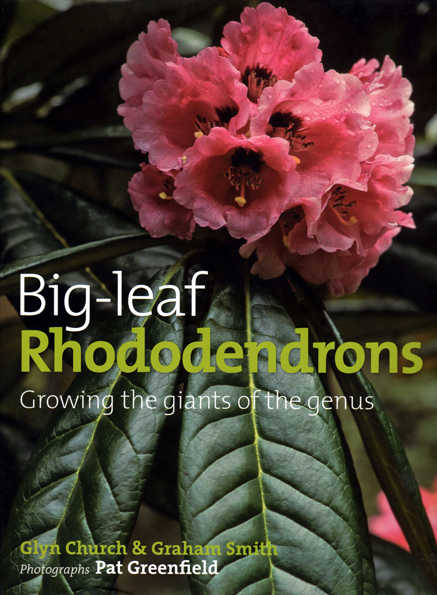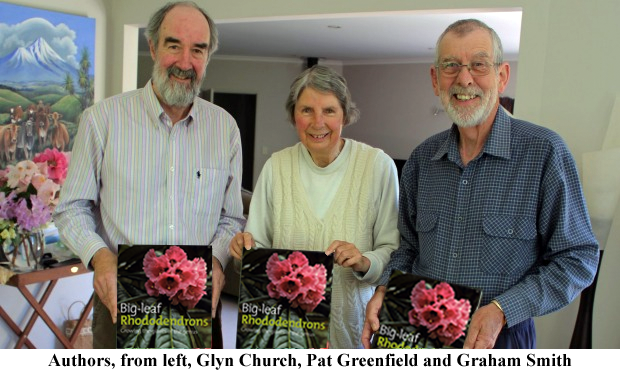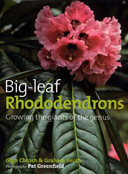You might ask, why I spent money on a book published in New Zealand about tender rhododendrons I can’t grow in Pennsylvania. There are a couple reasons. First, I am one of many that love the big-leaf rhododendrons (big-leafs) and always look for them when I travel. They are just as impressive whether they are in bloom or not. Second, this is a good rhododendron book, besides being a fascinating book about the big-leaf plants.
The forward is by Steve Hootman from the Rhododendron Species Foundation. He is impressed with the inclusion of the more newly discovered species and their habitat. This book describes over 30 species in the Falconera and Grandia subsections. It is written by Kiwis who have lived with big-leafs in cultivation in New Zealand and fallen in love with them.
The book’s introduction credits Britain’s loss in the American Revolution to isolating Britain from its supply of American rhododendron species and encouraging it to turn to India and Asia where they found a plethora of new and novel rhododendron species for plant hunters and their patrons, wealthy estate owners. The British love affair with the big-leafs began in earnest in mid-1800’s. The book not only details the history of exploration of rhododendrons, but also details the explorers from Hooker and Griffith in the early days to Steve Hootman and Ken Cox much more recently.
Besides describing the plant explorers, the book details the status of the regions being explored: Yunnan, Sichuan, Tibet, Vietnam, Myanmar, Bhutan, Sikkim, Nepal, Arunachal Pradesh, and some other Indian states. It includes an excellent map of this region.
The heart of the book is in describing the members of the Falconera subsection with their thick wooly indumentum, and the members of the Grandia subsection with their plastered indumentum and nectar pouches. Here we find out how big a big leaf is. For the Falconera subsection the leaves range up to 18” long for R. rex ssp. rex and plants are trees up to 80’ tall for R. falconeri and even taller for the new species R. titapuriense found by Ken Cox in 2000. The biggest trees with the biggest leaves are in the Grandia subsection. R. sinogrande has the largest leaves, being up to 36” long and 12” wide. The tallest members are R. protistum ssp. protistum and R. protistum ssp. giganteum with heights exceeding 100’.
All plants are fully described in words and pictures. Fortunately, the descriptions give hardiness in both the British rating system and the USDA Zone system. Unfortunately for me, most are hardy in Zones 8 and 9, with a few hardy to Zone 7. Also, dimensions are expressed both in metric and English.
Ever since the big-leafs were first grown in gardens, they have been successfully hybridized. The book describes 40 of the best big-leaf hybrids. One hybrid that stands out is Jim Burlap’s ‘Powder Snow” which is a R. degronianum ssp. yakushimanum x R. macabeanum cross that has great leaves on a compact plant. The flowers are white with a small red blotch. Fortunately, the yakushimanum influence included hardiness being hardy to 0°F.
|
Now that we are all pumped up about the big-leafs, where do we see them without going to the Himalayas. The book lists 23 gardens in the US, Canada, Scotland, England, Wales, and, of course, Australia and New Zealand. The good news is that I have visited about half of these gardens. The even better news is that there are just as many left to visit. In the US and Canada, it lists University of BC in Vancouver as well as the Species Foundation and Merkerk in WA.
The section on growing big-leaf rhododendrons is very well written and applies to rhododendrons in general. It emphasizes the need for both organic matter and drainage to provide adequate air and moisture to the roots. It also has in-depth sections on acidity and precautions in applying nutrients, mulching, and climate. The biggest difference in raising big-leafs as opposed to other rhododendrons, is that big-leafs need protection from sun, wind, drought, heat, and cold. This section emphasizes the need for deep-rooted shade trees such as pine and magnolia trees, especially with big-leafs. It encourages deadheading, but points out that it is difficult when the big-leafs grow to become trees.
The book points out that big-leafs have the same basic pests as other rhododendrons and the same remedies work. Leaf problems are less because of the indumentum on big-leafs. The book encourages the control of weevils with sticky substances applied to the main stem. It points out the stem borers are perhaps the worst enemy, and vigilance is the best control.
The section on propagation is rather extensive. It deals with seed, cuttings, grafting, and layering. Since big-leafs are typically species, seeds become a very viable way of propagating once they begin blooming. The difficulty in propagating using cuttings is the huge leaves which need to be reduced in size rather drastically. The book encourages taking cuttings in the late spring and using a strong hormone mix. Since many big-leafs are difficult to root, more success is achieved with layering and grafting. For the big-leafs that don’t have branches near the ground, air-layering is used. Grafting is often used for big-leafs. The book encourages nurse grafts where the union is covered with compost to encourage rooting from the scion.
The book concludes with sections on plant placement, companion plants, and the status of conservation efforts in all regions of the world where the big-leafs are native. The book is well illustrated with excellent quality photographs. Two of my favorite features are the glossary and index. Both are well done. As Steve Hootman says in the forward, “Readers will find Big-Leaf Rhododendrons: Growing the Giants of the Genus to be an entertaining, educational and unique addition to their horticultural library.”
|




 Click Here To Order:
Click Here To Order:
